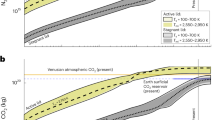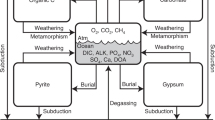Abstract
How the Earth stayed warm several billion years ago when the Sun was considerably fainter is the long-standing problem of the ‘faint young Sun paradox’. Because of negligible1 O2 and only moderate CO2 levels2 in the Archaean atmosphere, methane has been invoked as an auxiliary greenhouse gas3. Alternatively, pressure broadening in a thicker atmosphere with a N2 partial pressure around 1.6–2.4 bar could have enhanced the greenhouse effect4. But fossilized raindrop imprints indicate that air pressure 2.7 billion years ago (Gyr) was below twice modern levels and probably below 1.1 bar, precluding such pressure enhancement5. This result is supported by nitrogen and argon isotope studies of fluid inclusions in 3.0–3.5 Gyr rocks6. Here, we calculate absolute Archaean barometric pressure using the size distribution of gas bubbles in basaltic lava flows that solidified at sea level ∼2.7 Gyr in the Pilbara Craton, Australia. Our data indicate a surprisingly low surface atmospheric pressure of Patm = 0.23 ± 0.23 (2σ) bar, and combined with previous studies suggests ∼0.5 bar as an upper limit to late Archaean Patm. The result implies that the thin atmosphere was rich in auxiliary greenhouse gases and that Patm fluctuated over geologic time to a previously unrecognized extent.
This is a preview of subscription content, access via your institution
Access options
Subscribe to this journal
Receive 12 print issues and online access
$259.00 per year
only $21.58 per issue
Buy this article
- Purchase on Springer Link
- Instant access to full article PDF
Prices may be subject to local taxes which are calculated during checkout



Similar content being viewed by others
References
Holland, H. D. The oxygenation of the atmosphere and oceans. Phil. Trans. R. Soc. B 361, 903–915 (2006).
Sheldon, N. D. Precambrian paleosols and atmospheric CO2 levels. Precambr. Res. 147, 148–155 (2006).
Kasting, J. F. & Siefert, J. L. Life and the evolution of Earth’s atmosphere. Science 296, 1066–1068 (2002).
Goldblatt, C. et al. Nitrogen-enhanced greenhouse warming on early Earth. Nature Geosci. 2, 891–896 (2009).
Som, S. M., Catling, D. C., Harnmeijer, J. P., Polivka, P. M. & Buick, R. Air density 2.7 billion years ago limited to less than twice modern levels by fossil raindrop imprints. Nature 484, 359–362 (2012).
Marty, B., Zimmermann, L., Pujol, M., Burgess, R. & Philippot, P. Nitrogen isotopic composition and density of the Archean atmosphere. Science 342, 101–104 (2013).
Sahagian, D. L. & Maus, J. E. Basalt vesicularity as a measure of atmospheric pressure and palaeoelevation. Nature 372, 449–451 (1994).
Sahagian, D., Proussevitch, A. & Carlson, W. Analysis of vesicular basalts and lava emplacement processes for application as a paleobarometer/paleoaltimeter. J. Geol. 110, 671–685 (2002).
Sahagian, D., Proussevitch, A. & Carlson, W. Timing of Colorado Plateau uplift: initial constraints from vesicular basalt-derived paleoelevations. Geology 30, 807–810 (2002).
Flowers, R. & Farley, K. Apatite 4He/3He and (U-Th)/He evidence for an ancient Grand Canyon. Science 338, 1616–1619 (2012).
Xia, G. Q., Yi, H. S., Zhao, X. X., Gong, D. X. & Ji, C. J. A late Mesozoic high plateau in eastern China: evidence from basalt vesicular paleoaltimetry. Chin. Sci. Bull. 57, 2767–2777 (2012).
Aydar, E. et al. Central Anatolian Plateau, Turkey: incision and paleoaltimetry recorded from volcanic rocks. Turk. J. Earth Sci. 22, 739–746 (2013).
Aubele, J. C., Crumpler, L. & Elston, W. E. Vesicle zonation and vertical structure of basalt flows. J. Volcanol. Geotherm. Res. 35, 349–374 (1988).
Hon, K., Kauahikaua, J., Denlinger, R. & Mackay, K. Emplacement and inflation of pahoehoe sheet flows: observations and measurements of active lava flows on Kilauea Volcano, Hawaii. Geol. Soc. Am. Bull. 106, 351–370 (1994).
Moore, J. G. Density of basalt core from Hilo drill hole, Hawaii. J. Volcanol. Geotherm. Res. 112, 221–230 (2001).
Blake, T. S. Late Archaean crustal extension, sedimentary basin formation, flood basalt volcanism and continental rifting: the Nullagine and Mount Jope Supersequences, Western Australia. Precambr. Res. 60, 185–241 (1993).
Som, S. M. et al. Quantitative discrimination between geological materials with variable density contrast by high resolution X-ray computed tomography: an example using amygdule size-distribution in ancient lava flows. Comput. Geosci. 54, 231–238 (2013).
Ketcham, R. A. Computational methods for quantitative analysis of three-dimensional features in geological specimens. Geosphere 1, 32–41 (2005).
Berner, R. Geological nitrogen cycle and atmospheric N2 over Phanerozoic time. Geology 34, 413–415 (2006).
Busigny, V., Cartigny, P. & Philippot, P. Nitrogen isotopes in ophiolitic metagabbros: a re-evaluation of modern nitrogen fluxes in subduction zones and implication for the early Earth atmosphere. Geochim. Cosmochim. Acta 75, 7502–7521 (2011).
Turner, G. The outgassing history of the Earth’s atmosphere. J. Geol. Soc. Lond. 146, 147–154 (1989).
Navarro-González, R., McKay, C. P. & Mvondo, D. N. A possible nitrogen crisis for Archaean life due to reduced nitrogen fixation by lightning. Nature 412, 61–64 (2001).
Zahnle, K. J. Photochemistry of methane and the formation of hydrocyanic acid (HCN) in the Earth’s early atmosphere. J. Geophys. Res. 91, 2819–2834 (1986).
Kasting, J. F. & Siefert, J. L. The nitrogen fix. Nature 412, 26–27 (2001).
Stüeken, E., Buick, R., Guy, B. & Koehler, M. C. Isotopic evidence for biological nitrogen fixation by molybdenum-nitrogenase from 3.2 Gyr. Nature 520, 666–669 (2015).
Papineau, D., Mojzsis, S., Karhu, J. & Marty, B. Nitrogen isotopic composition of ammoniated phyllosilicates: case studies from Precambrian metamorphosed sedimentary rocks. Chem. Geol. 216, 37–58 (2005).
Holland, H. Volcanic gases, black smokers, and the Great Oxidation Event. Geochim. Cosmochim. Acta 66, 3811–3826 (2002).
Honma, H. High ammonium contents in the 3800 Ma Isua supracrustal rocks, central West Greenland. Geochim. Cosmochim. Acta 60, 2173–2178 (1996).
Mikhail, S. & Sverjensky, D. A. Nitrogen speciation in upper mantle fluids and the origin of Earth’s nitrogen-rich atmosphere. Nature Geosci. 7, 2–5 (2014).
Hersterberg, T., Moore, D. S., Monaghan, S., Clipson, A. & Epstein, R. in Introduction to the Practice of Statistics (eds Moore, D. S. & McCabe, G. P.) (W. H. Freeman, 2012).
Acknowledgements
This work was supported by NASA Exobiology/Astrobiology grant NNX08AP56G to R.B. Additional support came from NASA Astrobiology Institute grant NNA13AA93A. The Washington State University Geoanalytical Laboratory performed the major- and trace-element analyses. S.M.S. thanks E. Stüeken for insightful conversations on K+ replacement in clays. We thank S. Mikhail, D. Sahagian and B. Marty for helpful reviews.
Author information
Authors and Affiliations
Contributions
R.B. conceived the project and led the field work in Western Australia, T.S.B. discovered the locality, J.P.H. assisted in mapping the locality, D.C.C. supervised the data analysis and contributed to the geologic N cycle interpretation, J.W.H. supervised the X-ray work, J.M.P. assisted in extracting amygdale dimensions, S.M.S. assisted in the Beasley River field work, prepared samples for analysis, X-rayed the cores, developed the algorithm to analyse the X-ray images, led the amygdale dimension extraction task, analysed the data, and contributed to the geologic N cycle interpretation. S.M.S., R.B. and D.C.C. wrote the manuscript.
Corresponding author
Ethics declarations
Competing interests
The authors declare no competing financial interests.
Supplementary information
Supplementary Information
Supplementary Information (PDF 4882 kb)
Supplementary Information
Supplementary Information (ZIP 383 kb)
Rights and permissions
About this article
Cite this article
Som, S., Buick, R., Hagadorn, J. et al. Earth's air pressure 2.7 billion years ago constrained to less than half of modern levels. Nature Geosci 9, 448–451 (2016). https://doi.org/10.1038/ngeo2713
Received:
Accepted:
Published:
Issue Date:
DOI: https://doi.org/10.1038/ngeo2713
This article is cited by
-
Modern analogs for ammonia flux from terrestrial hydrothermal features to the Archean atmosphere
Scientific Reports (2024)
-
Venus’s atmospheric nitrogen explained by ancient plate tectonics
Nature Astronomy (2023)
-
The Habitability of Venus
Space Science Reviews (2023)
-
The Long-Term Evolution of the Atmosphere of Venus: Processes and Feedback Mechanisms
Space Science Reviews (2022)
-
High nitrogen solubility in stishovite (SiO2) under lower mantle conditions
Scientific Reports (2020)



